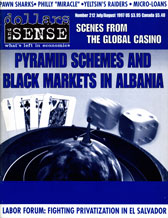Taking Aim at Child Slavery
This article is from the July/August 1997 issue of Dollars and Sense: The Magazine of Economic Justice available at http://www.dollarsandsense.org
This article is from the July/August 1997 issue of Dollars & Sense magazine.

If the Persian-style carpets at your local store do not have Rugmark's signature stamp of a smiling face, chances are enslaved children made them. Rugmark is a two-year-old label founded by a coalition of German and Indian groups whose inspectors ensure that participating carpet producers use neither enslaved nor "free" child workers.
Last year, Rugmark-labeled rugs became available in the United States. This is only appropriate, since German and American consumers buy 75% of India's carpet exports. So far, over 200 carpet makers in India, Nepal and Pakistan pay the label a small fee to participate. More than 250,000 of their rugs have been exported with child-free labor, and their fees have funded education and rehabilitation programs for released children.
In taking aim at child slavery and child labor, Rugmark does not have it easy. Profits are high and slave labor endemic to these countries, even though international law and their own legal codes forbid it. In South Asia, 90% of child carpet workers are slaves, says UNICEF. In India alone, the carpet industry is a $700 million business, so it is not surprising that government officials and local police overlook or even cover up the practice. It garners support from the poorest to richest sectors of society.
Millions of children are enslaved throughout the world—15 million are in India alone. But everywhere the process is the same. Unable to obtain credit from banks, desperate parents sell their child in exchange for a small loan from unscrupulous employers. Sometimes a child will inherit the debt from other family members. The child has no say in the matter, and may work years, sometimes a lifetime, to pay off the loan. Meanwhile the employer completely controls the worker's activities, and in many cases, the worker's family. The child can be sold anytime to another master. It is called "bonded labor," says Human Rights Watch, but it is still slavery.
Debt bondage in the carpet industry, like every form of child labor, is hazardous. In Pakistan, private jails exist for insubordinates. Most bonded weavers eat, sleep and work in the same small carpet shed under unhealthy conditions. It is not uncommon for children to work 14 to 18 hours a day, seven days a week. While working in a crouched position at looms for long periods of time, children often suffer permanent physical deformities. And constant contact with woolen fluff in poorly ventilated rooms causes skin rashes and lung problems. The dark environment often destroys eyesight. If they get too slow, make a mistake or complain, the children are beaten, tortured or even murdered.
More appalling, many carpet sheds act as recruitment centers for brothels, according to Human Rights Watch's 1995 report, Rape for Profit. In Nepal, many bonded girls get sold from carpet sheds to Indian brothels. In the brothels, their only wages are tips from patrons, usually less than 15 cents. When most finally return home to Nepal, nearly all have the HIV virus. The typical age for recruiting is now 10 to 14 years old.
With growing protest against bonded labor, these carpet-exporting countries are crying foul or even denying its existence. After the Labor Commissioner of Rajasthan, a state in India, told Human Rights Watch it did not exist, investigators found slavery, even of entire families, rampant.
Although the countries insist boycott campaigns are "protectionist" gestures aimed at weakening their business, the publicity has yet to seriously damage the carpet-export industry. In India it grows about 10% every year with more than 100 times more exporters operating than 20 years ago. Pakistani and Indian sources tell us the number of child laborers increases 5% every year.
But attacking child slavery must go beyond carpets. If only the carpet business eliminated child slavery, other industries would just pick up the released workers. In Bangladesh, according to UNICEF, under foreign pressure, the garment industry in 1993 released about 50,000 child laborers, mostly girls. A study confirmed that many of those released found work in more dangerous stone crushing, street hustling and prostitution. And enslaved children working in the export-producing sector are only a small portion of all child slaves.
Since international trade organizations are not punishing bandit countries, the Rugmark campaign plays a necessary role in mobilizing consumers. We must force these countries to abide by international law. They must prosecute and punish those who enslave children, and make credit available to poor families so they are not forced to sell their children. Following Rugmark's example, we need campaigns targeting other industries that enslave children, such as agriculture and prostitution. U.S. law must be made less ambiguous about whether it is legal to import goods made by children, free or enslaved, which a bill introduced by Senator Tom Harkin (D-Iowa) would accomplish.
